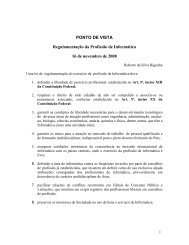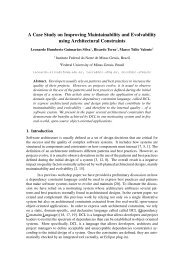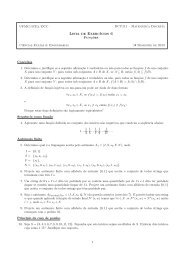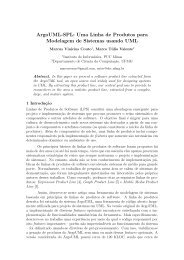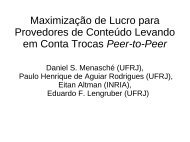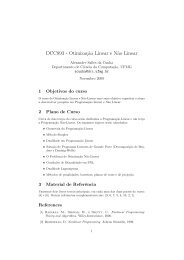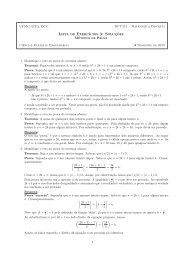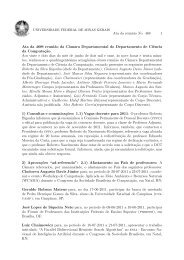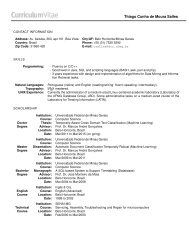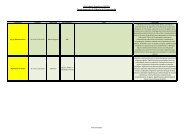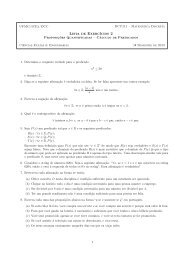Predicting post-synaptic activity in proteins - ResearchGate
Predicting post-synaptic activity in proteins - ResearchGate
Predicting post-synaptic activity in proteins - ResearchGate
Create successful ePaper yourself
Turn your PDF publications into a flip-book with our unique Google optimized e-Paper software.
G.L.Pappa et al.<br />
Fig. 1. Ma<strong>in</strong> elements <strong>in</strong>volved <strong>in</strong> pre-<strong>synaptic</strong> and <strong>post</strong>-<strong>synaptic</strong> <strong>activity</strong>.<br />
A synapse is the po<strong>in</strong>t where two nerve cells communicate with each other by<br />
transmission of a chemical known as a neurotransmitter. The ma<strong>in</strong> elements<br />
found <strong>in</strong> synapses are shown <strong>in</strong> Figure 1. The cells are held together by<br />
cell adhesion molecules (1). In the cell where the signal is com<strong>in</strong>g from<br />
(the pre-<strong>synaptic</strong> cell) neurotransmitters are stored <strong>in</strong> bags called <strong>synaptic</strong><br />
vesicles. When signals are to be transmitted from the pre-<strong>synaptic</strong> cell to the<br />
<strong>post</strong>-<strong>synaptic</strong> cell, <strong>synaptic</strong> vesicles fuse with the pre-<strong>synaptic</strong> membrane and<br />
release their contents <strong>in</strong>to the <strong>synaptic</strong> cleft between the cells. The transmitters<br />
then diffuse with<strong>in</strong> the cleft, and some of them meet a <strong>post</strong>-<strong>synaptic</strong> receptor<br />
(2), which recognises them as a signal. This activates the receptor, which<br />
then transmits the signal on to other signall<strong>in</strong>g components such as voltagegated<br />
ion channels (3), prote<strong>in</strong> k<strong>in</strong>ases (4) and phosphatases (5). To ensure<br />
that the signal is term<strong>in</strong>ated and to clear up residual neurotransmitters after<br />
the signal has term<strong>in</strong>ated, transporters (6) remove neurotransmitters from the<br />
cleft. With<strong>in</strong> the <strong>post</strong>-<strong>synaptic</strong> cell, the signall<strong>in</strong>g apparatus is organised by<br />
various scaffold<strong>in</strong>g prote<strong>in</strong>s (7).<br />
nature of this project, which is, of course, a desirable feature <strong>in</strong> a<br />
bio<strong>in</strong>formatics project.<br />
The rema<strong>in</strong>der of this paper is organised as follows: Section 2<br />
describes the target biological problem; Section 3 describes the<br />
preparation of the dataset for m<strong>in</strong><strong>in</strong>g purposes, by us<strong>in</strong>g prote<strong>in</strong><br />
data available <strong>in</strong> UniProt/SwissProt and Prosite; Section 4 discusses<br />
the proposed data m<strong>in</strong><strong>in</strong>g approach and the correspond<strong>in</strong>g analysis<br />
of results; f<strong>in</strong>ally, Section 5 reports the conclusions and future<br />
research directions.<br />
2 THE TARGET BIOLOGICAL PROBLEM<br />
In essence, <strong>post</strong>-<strong>synaptic</strong> sites represent po<strong>in</strong>ts where one nerve cell<br />
receives signals from another. As <strong>in</strong>dicated <strong>in</strong> Figure 1, multiple<br />
types of prote<strong>in</strong>s are expected to be found at these sites for reception<br />
and propagation of signals, and for jo<strong>in</strong><strong>in</strong>g the two nerve cells to each<br />
other. Note that Figure 1 is a very m<strong>in</strong>imal summary of the types of<br />
prote<strong>in</strong>s found <strong>in</strong> <strong>post</strong><strong>synaptic</strong> sites.<br />
The bio<strong>in</strong>formatics problem be<strong>in</strong>g addressed <strong>in</strong> this paper is to predict<br />
whether or not a prote<strong>in</strong> has <strong>post</strong>-<strong>synaptic</strong> <strong>activity</strong>. This problem<br />
is of great <strong>in</strong>tr<strong>in</strong>sic <strong>in</strong>terest because prote<strong>in</strong>s with <strong>post</strong>-<strong>synaptic</strong> activities<br />
are connected with function<strong>in</strong>g of the nervous system. Indeed,<br />
many prote<strong>in</strong>s hav<strong>in</strong>g <strong>post</strong>-<strong>synaptic</strong> <strong>activity</strong> have been functionally<br />
characterized by biochemical, immunological and proteomic exercises<br />
[see e.g. Husi et al. (2000) and Walikonis et al. (2000)], and are<br />
ii20<br />
now extensively catalogued and annotated <strong>in</strong> the Uniprot/SwissProt<br />
database. They represent a wide variety of prote<strong>in</strong>s with functions <strong>in</strong><br />
extracellular signal reception and propagation through <strong>in</strong>tracellular<br />
apparatuses, cell adhesion molecules and scaffold<strong>in</strong>g prote<strong>in</strong>s that<br />
l<strong>in</strong>k them <strong>in</strong> a web.<br />
The challenge is to automatically discover features of prote<strong>in</strong>s’<br />
primary sequences that typically occur <strong>in</strong> prote<strong>in</strong>s with <strong>post</strong>-<strong>synaptic</strong><br />
<strong>activity</strong> but rarely (or never) occur <strong>in</strong> prote<strong>in</strong>s without <strong>post</strong>-<strong>synaptic</strong><br />
<strong>activity</strong>, and vice-versa. These discovered features constitute the<br />
essence of the knowledge discovered by a data m<strong>in</strong><strong>in</strong>g algorithm.<br />
If the algorithm is successful <strong>in</strong> discover<strong>in</strong>g knowledge with a high<br />
predictive power, that knowledge can be used to accurately discrim<strong>in</strong>ate<br />
between the two classes of prote<strong>in</strong>s. In addition, and<br />
most important, the fact that <strong>in</strong> this project discovered knowledge<br />
will be expressed <strong>in</strong> a comprehensible form—as mentioned <strong>in</strong> the<br />
Introduction—represents potentially valuable knowledge by itself,<br />
because such knowledge can potentially give new <strong>in</strong>sights to biologists<br />
about which sequence features are predictive of <strong>post</strong>-<strong>synaptic</strong><br />
<strong>activity</strong>.<br />
3 METHODS<br />
The goal of this project is to predict—with a data m<strong>in</strong><strong>in</strong>g algorithm—whether<br />
or not a prote<strong>in</strong> has <strong>post</strong>-<strong>synaptic</strong> <strong>activity</strong>. The algorithm is used to discover<br />
<strong>in</strong>terest<strong>in</strong>g relationships between sequence features that are often present <strong>in</strong><br />
<strong>post</strong>-<strong>synaptic</strong> prote<strong>in</strong>s but usually absent <strong>in</strong> prote<strong>in</strong>s without <strong>post</strong>-<strong>synaptic</strong><br />
prote<strong>in</strong>s, and vice-versa. Therefore, <strong>in</strong> order to discover this k<strong>in</strong>d of knowledge,<br />
we need not only a set of <strong>post</strong>-<strong>synaptic</strong> prote<strong>in</strong>s but also a control set<br />
of prote<strong>in</strong>s which do not have <strong>post</strong>-<strong>synaptic</strong> <strong>activity</strong>.<br />
In data m<strong>in</strong><strong>in</strong>g term<strong>in</strong>ology, the set of prote<strong>in</strong>s with <strong>post</strong>-<strong>synaptic</strong> <strong>activity</strong><br />
is called the set of positive examples, whereas the control set of prote<strong>in</strong>s<br />
(without <strong>post</strong>-<strong>synaptic</strong> <strong>activity</strong>) is called the set of negative examples. The<br />
problem of f<strong>in</strong>d<strong>in</strong>g sequence features that discrim<strong>in</strong>ate between these two<br />
k<strong>in</strong>ds of prote<strong>in</strong>s is then cast as a classification problem, where the goal is<br />
to predict the value of a class attribute for each example (prote<strong>in</strong>) based on<br />
a set of predictor attributes for that example. The classes are whether or not<br />
a prote<strong>in</strong> has <strong>post</strong>-<strong>synaptic</strong> <strong>activity</strong>, and the predictor attributes are ma<strong>in</strong>ly<br />
Prosite patterns, as described below.<br />
More precisely, the dataset m<strong>in</strong>ed <strong>in</strong> this project was constructed <strong>in</strong><br />
two phases. In the first phase we carefully selected relevant prote<strong>in</strong>s<br />
from the UniProt database. UniProt (Universal Prote<strong>in</strong> Resource) was<br />
created by the union of Swiss-Prot, TrEMBL and PIR databases, and<br />
is a repository for prote<strong>in</strong> sequence and functional data (Uniprot, 2004,<br />
http://www.ebi.uniprot.org/<strong>in</strong>dex.shtml). UniProt was chosen as the source<br />
of the data to be m<strong>in</strong>ed because it is the world standard non-redundant,<br />
comprehensive prote<strong>in</strong> sequence database. UniProt is divided <strong>in</strong> three<br />
database layers: UniParc (UniProt Archive), UniProt Knowledgebase (Uni-<br />
Prot/SwissProt) and UniProt NREF (UniRef). In this research we have used<br />
UniProt/SwissProt, which is the richest annotated layer. One of the great<br />
advantages of this layer is the comprehensive annotation of SwissProt. This<br />
is curated to ensure m<strong>in</strong>imal redundancy, accurate and comprehensive annotation<br />
of function, expression, sequence features (e.g. doma<strong>in</strong> structures),<br />
literature references, l<strong>in</strong>ks to other databases, etc.<br />
The second phase of data preparation used the l<strong>in</strong>ks from Unit-<br />
Prot/SwissProt to the Prosite database, <strong>in</strong> order to retrieve <strong>in</strong>formation from<br />
Prosite that was used to create the predictor attributes. These two phases are<br />
described <strong>in</strong> detail next.<br />
3.1 Phase 1: select<strong>in</strong>g positive and negative examples<br />
Table 1 shows the queries submitted to UniProt/SwissProt <strong>in</strong> order to select the<br />
set of positive examples (prote<strong>in</strong>s with <strong>post</strong>-<strong>synaptic</strong> <strong>activity</strong>) and the set of<br />
negative examples (prote<strong>in</strong>s without <strong>post</strong>-<strong>synaptic</strong> <strong>activity</strong>). For each query,<br />
the table shows the specification of the query and the number of examples



